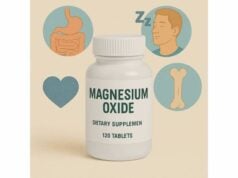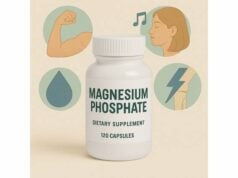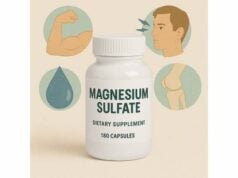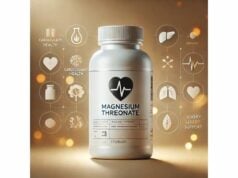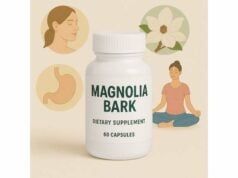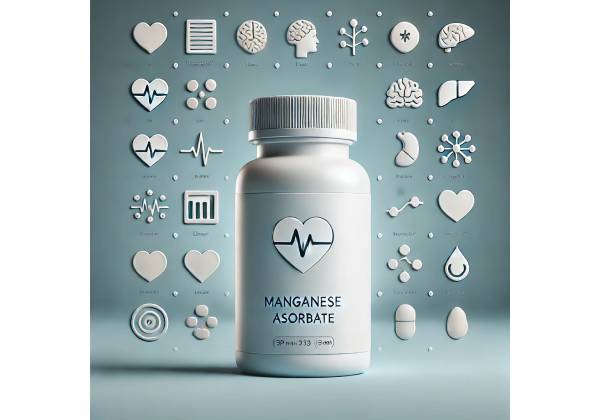
Manganese ascorbate combines two familiar nutrients in a single compound: manganese, an essential trace mineral, and ascorbic acid, better known as vitamin C. Together, they appear in joint blends, general mineral formulas, and some targeted antioxidant products. Manganese supports enzymes that build cartilage and bone and protect cells from oxidative stress; vitamin C contributes to collagen formation and immune function. You will also see manganese ascorbate used as the “source” of manganese on Supplement Facts labels, meaning a product may provide elemental manganese while the anion is ascorbate. While manganese deficiency is uncommon, understanding when, how, and how much to use can help you avoid shortfalls without drifting into unnecessary or risky intakes. This guide translates the science into practical steps: what benefits are realistic, how to dose by elemental manganese, what to combine or avoid, and how to spot side effects early. If you have osteoarthritis, take thyroid medication, or have liver disease, the safety notes are especially important.
Essential Insights
- Supports manganese-dependent enzymes for cartilage, bone, and antioxidant defense.
- May help knee osteoarthritis symptoms when used within combination formulas.
- Typical supplemental intake: 1–3 mg elemental manganese/day from manganese ascorbate.
- Separate from tetracyclines or fluoroquinolones to prevent reduced antibiotic absorption.
- Avoid high-dose manganese if you have liver disease or significant occupational manganese exposure.
Table of Contents
- What is manganese ascorbate?
- Benefits you can expect
- How to use it correctly
- Factors that change absorption
- Mistakes and troubleshooting
- Side effects and interactions
What is manganese ascorbate?
Manganese ascorbate is a salt formed from manganese and ascorbic acid. In nutrition, it serves two roles. First, it can act as a delivery form of elemental manganese, the small amount of manganese your body actually uses. Second, because the counter-ion is ascorbate, it also contributes a minor amount of vitamin C. On supplement labels in the United States, the amount listed for manganese is the elemental amount, followed by the source in parentheses—for example, “Manganese (as manganese ascorbate) 2 mg.” That 2 mg refers to manganese itself, not the full weight of the entire compound.
Why manganese matters: it is a cofactor for several enzymes that keep connective tissues and cells functioning. These include glycosyltransferases that help build proteoglycans in cartilage and bone; manganese superoxide dismutase (MnSOD), the primary antioxidant enzyme inside mitochondria; arginase, involved in the urea cycle; and pyruvate carboxylase, important for energy metabolism. By supporting these enzymes, adequate manganese contributes to bone formation, normal wound healing, and cellular resilience to oxidative stress. Because dietary intake in most adults averages around a few milligrams per day from whole grains, legumes, nuts, and tea, outright deficiency is rare; however, intakes can be lower in restrictive diets or when overall mineral consumption is inconsistent.
Vitamin C (ascorbate) adds complementary support. It is required for collagen maturation, which is crucial in tendons, ligaments, and skin. Many “joint” and “connective tissue” supplements include both manganese and vitamin C—either separately or together as manganese ascorbate—on the rationale that manganese supports proteoglycans while vitamin C supports collagen. That biochemical pairing, plus a long record of safe use at modest doses, explains why manganese ascorbate appears broadly in joint blends and multinutrient formulas.
Not all manganese compounds behave differently in the body. For manganese, there is no convincing evidence that one supplemental form (ascorbate, gluconate, sulfate, citrate, or amino acid chelates) is consistently more bioavailable or effective than another at typical doses. The body primarily regulates manganese status by adjusting absorption in the small intestine and excretion via bile. When dietary manganese is low, absorption goes up; when intake rises, absorption drops. In healthy adults, only about 1% to 5% of dietary manganese is absorbed, which is one reason routine supplement doses are small.
In short: manganese ascorbate is a practical, well-tolerated way to deliver small, physiologic amounts of manganese, often alongside a modest bump in vitamin C. It is not intended for high-dose manganese therapy, and—like any manganese supplement—its benefits are tied to the needs of manganese-dependent enzymes rather than to a stimulant or drug-like effect you feel right away.
Benefits you can expect
Joint comfort and function (within combination formulas). The best-studied use of manganese ascorbate is as part of multi-ingredient combinations for mild to moderate knee osteoarthritis. Two randomized, placebo-controlled trials tested a daily regimen that paired glucosamine hydrochloride and chondroitin sulfate with manganese ascorbate for several months in adults with knee osteoarthritis. Participants receiving the combination showed statistically significant improvements in validated symptom scores versus placebo, particularly in those with mild to moderate disease. These studies attribute the benefit to the combination, not to manganese ascorbate alone, but the inclusion of manganese is rational: manganese-dependent enzymes support cartilage matrix production, while vitamin C supports collagen cross-linking.
Connective tissue support. Even outside of osteoarthritis, manganese ascorbate contributes to the enzymatic machinery that maintains cartilage, bone, tendons, and skin. People recovering from orthopedic stress or pursuing higher training loads sometimes include manganese—usually in the 1–3 mg/day range—as one of several micronutrients to cover bases for collagen and proteoglycan turnover. Because vitamin C is frequently co-formulated, a manganese ascorbate capsule or powder can help top up daily vitamin C if the rest of your diet is uneven.
Mitochondrial antioxidant defense. MnSOD is the primary defense against superoxide radicals in mitochondria. Adequate manganese supports MnSOD activity, which in turn helps cells manage oxidative stress generated during normal metabolism and exercise. This is not a license to mega-dose manganese; the enzyme saturates at physiologic levels, and excess manganese does not increase antioxidant capacity in a linear way. Think “remove a bottleneck if there is one,” not “more is always better.”
Filling small gaps. Multivitamin and multimineral products often include manganese because typical diets vary and because intake is harder to predict when people avoid whole grains, legumes, and tea. If your multivitamin uses manganese ascorbate, you are effectively getting a small, steady contribution of both manganese and vitamin C.
What manganese ascorbate does not do on its own: it is not a direct painkiller, it does not rebuild cartilage by itself, and it will not “boost metabolism.” Benefits, when present, are supportive and often subtle, emerging over weeks as part of a broader routine (nutrition, sleep, activity, weight management, and—where relevant—first-line osteoarthritis care).
Who is most likely to notice benefit? Adults whose baseline diet is low in manganese-rich foods, people using a multinutrient joint formula with realistic expectations, and individuals ensuring they meet—but do not exceed—daily manganese needs for enzyme function. Those hoping for fast symptom relief should not expect manganese ascorbate to act like an NSAID; any improvements will be gradual and, in osteoarthritis, tied to combination protocols.
How to use it correctly
Dose by elemental manganese. The number to focus on is the elemental manganese listed on the Supplement Facts label. For most healthy adults, a practical supplemental range is 1–3 mg elemental manganese per day, particularly if your multivitamin or diet already contributes some manganese. Many multivitamins supply between 1.0 and 4.5 mg. Products that contain only manganese (or manganese plus a few nutrients) sometimes provide 5–20 mg, which is more than most people need and can accumulate if you also take a multivitamin.
Know the tolerable upper limit (UL). For adults, the UL for manganese intake from all sources is commonly cited as 11 mg/day. This is not a target; it is a safety boundary designed to avoid neurotoxic risk in the general population. Because real-world exposure also includes food and water, aim for a comfortable buffer by keeping total supplemental manganese modest unless advised otherwise by your clinician. People with liver or bile duct disease need even more caution because manganese is excreted primarily via bile.
Timing with meals. Manganese absorption is relatively low and regulated by the body. Taking manganese ascorbate with a meal is reasonable and may reduce stomach upset. There is no advantage to taking it on an empty stomach. If the product is part of a joint combination, follow the label schedule (e.g., twice daily) to match how it was studied.
Combination examples. In osteoarthritis trials testing a three-component blend, manganese ascorbate was included alongside daily glucosamine hydrochloride and chondroitin sulfate for several months. The exact amounts in those studies were specified as milligrams of manganese ascorbate compound, while modern labels typically state elemental manganese. Use current labels to guide your total elemental manganese intake rather than trying to convert old compound weights.
Cycles and duration. For general micronutrient coverage, manganese ascorbate can be taken continuously at low doses as part of a multivitamin. For joint formulas, evaluate progress after 8–12 weeks of consistent use. If you do not notice worthwhile improvement by then, consider stopping and re-assessing your approach with your clinician.
Who might need less—or none? If your diet regularly includes whole grains, nuts, legumes, and tea, you may already meet your daily manganese needs without supplementation. If you drink water with naturally high manganese, or you have cholestasis or other liver issues, discuss supplements with your healthcare provider before adding manganese.
Vitamin C context. Manganese ascorbate contributes vitamin C, but often not enough to replace a dedicated vitamin C supplement. If you take separate vitamin C, remember the commonly recommended upper intake level for vitamin C is 2,000 mg/day for adults due to gastrointestinal tolerance. Count all sources to avoid unnecessary excess.
Practical starting template.
- Multivitamin that includes 1–2 mg elemental manganese from manganese ascorbate: start there; no additional manganese is usually needed.
- Joint formula that includes manganese ascorbate: ensure your total elemental manganese from all products stays in the low single-digit milligrams per day.
- Standalone manganese ascorbate: if used, cap at 1–3 mg elemental manganese daily unless your clinician recommends otherwise.
Factors that change absorption
Mineral competition. Divalent and trivalent minerals compete in the gut. High iron status tends to decrease manganese absorption, while iron deficiency can increase it. This is one reason iron-deficient individuals may be more vulnerable to excess manganese from environmental sources. Calcium and phosphorus can also affect manganese uptake at high intakes, although the effect is less predictable in everyday diets.
Form of manganese and regulatory control. Whether manganese arrives as ascorbate, gluconate, sulfate, or another common form, your intestines still absorb only a small portion—typically 1% to 5%—and your liver excretes most excess via bile. Because of this tight regulation, switching forms rarely produces a dramatic change in status at typical doses. What does matter is total intake over time and the health of your biliary system.
Food matrix and beverages. Whole grains, legumes, nuts, and tea supply meaningful manganese. Tea can be a substantial contributor in habitual tea drinkers. If you begin a supplement while also increasing intake of these foods, your combined exposure rises. Conversely, a low-grain or low-legume diet may reduce manganese intake below desirable levels, making a small supplemental dose more relevant.
Water and environment. In some regions, well water can contain elevated manganese. If you rely on well water, consider testing it—especially for infants and during pregnancy. Occupational inhalation exposure (e.g., welding) is a separate pathway with different risks than oral intake and should be managed by occupational health safeguards rather than by nutrition alone.
Medication interactions that reduce drug absorption. Minerals can form complexes with certain antibiotics that impair antibiotic absorption. Tetracyclines and fluoroquinolones are the classic examples. If you use manganese ascorbate and are prescribed one of these antibiotics, separate dosing—often by several hours—is standard practice to avoid chelation in the gut. Likewise, many clinicians recommend separating minerals from thyroid hormone tablets to prevent inconsistent hormone absorption; check the timing guidance you received with your prescription.
Age, pregnancy, and liver health. Infants absorb a higher proportion of ingested manganese than adults. Adults with normal liver and biliary function excrete manganese efficiently; those with impaired excretion (e.g., cholestasis) do not. During pregnancy and lactation, daily manganese requirements are modestly higher, but that does not justify high supplemental doses; a well-balanced diet or low-dose multivitamin usually suffices.
Takeaway. Your body’s manganese status reflects diet quality, water source, liver function, and the timing of other minerals and medications. Supplements add one controllable piece to that picture. Focus on elemental manganese totals, keep doses modest, and space minerals away from susceptible medications.
Mistakes and troubleshooting
Mistake 1: Confusing compound weight with elemental manganese. Older studies sometimes list milligrams of manganese ascorbate compound, not elemental manganese. Modern labels list elemental manganese. If your product lists the salt weight, you cannot compare it directly to your daily needs or the UL. Prefer labels that specify elemental content so you can tally your total daily intake accurately.
Mistake 2: Stacking products. It is easy to take a multivitamin with 2 mg manganese, plus a joint formula with additional manganese, plus a dedicated mineral supplement. Add in a high-manganese diet and tea, and you may exceed prudent daily totals. Solution: choose one primary source and keep the rest manganese-free, or verify that the sum of elemental manganese from all supplements remains in the low single-digit milligrams.
Mistake 3: Taking with interacting antibiotics. Co-ingesting manganese ascorbate with tetracyclines or fluoroquinolones can reduce antibiotic absorption. Fix: take manganese-containing supplements well separated from these medications based on your pharmacist’s instructions. If you are unsure, hold the supplement during the antibiotic course.
Mistake 4: Expecting drug-like effects. Manganese ascorbate supports enzymes; it does not act like an analgesic. In osteoarthritis, any benefit appears in combination with glucosamine and chondroitin and requires consistent use over weeks to months. Fix: set expectations accordingly and combine with foundational care (appropriate activity, weight management, sleep, and clinician-guided therapies).
Mistake 5: Ignoring liver or bile duct issues. Because manganese is excreted via bile, impaired biliary flow raises the risk of accumulation. Fix: if you have cholestasis, primary sclerosing cholangitis, or other liver conditions, do not self-supplement manganese. Discuss with your hepatology or primary care team first.
Mistake 6: Using high doses unnecessarily. Some single-nutrient products deliver 5–20 mg manganese per serving. That is rarely needed. Fix: match your dose to your actual diet and goals. For general coverage, 1–3 mg/day is typically ample. Consider cycling off if your diet improves.
Troubleshooting common issues:
- Mild stomach upset: Take with food or switch to a different time of day.
- No perceived benefit after 12 weeks on a joint blend: Re-evaluate dose, adherence, and whether glucosamine/chondroitin are appropriate for your severity of osteoarthritis; discontinue if ineffective.
- Concern about total exposure: List all sources (supplements, multivitamins, joint blends, diet, water) and calculate your daily total of elemental manganese. Aim comfortably below the UL unless medically supervised.
A simple habit—read labels carefully and track elemental manganese—prevents most problems and ensures manganese ascorbate plays a supportive, not risky, role in your plan.
Side effects and interactions
Typical tolerance. At modest doses, manganese ascorbate is usually well tolerated. Occasional users report mild gastrointestinal discomfort when taking minerals on an empty stomach; taking with food usually resolves this.
Signs you are getting too much. Because manganese is primarily excreted in bile, chronic excess shows up slowly. Early nonspecific signs can include fatigue, headache, irritability, or sleep changes. At higher, sustained exposures—especially in the context of impaired biliary excretion—neurologic symptoms may appear (e.g., slowed movements, tremor). These risks rise with total exposure from all sources, including water and occupational inhalation; supplements should not drive you near that territory.
Groups who should avoid or seek medical guidance first:
- Liver or biliary disease (cholestasis, cirrhosis, bile duct obstruction): impaired excretion increases accumulation risk.
- Pregnancy and lactation: needs are modest; avoid high-dose manganese supplements unless advised by your clinician.
- Infants and children: higher absorption fractions make them more sensitive to exposure; supplements should be clinician-directed only.
- Occupational exposure to manganese (e.g., welding, mining): minimize supplemental manganese unless a healthcare professional reviews your total exposure.
- Parkinsonism or parkinsonian symptoms: discuss with your neurologist before using manganese-containing supplements.
Drug interactions to manage:
- Tetracyclines and fluoroquinolones: Divalent and trivalent minerals, including manganese, can chelate these antibiotics and reduce their absorption. Separate dosing according to pharmacist guidance (commonly several hours apart) or pause mineral supplements during the antibiotic course.
- Thyroid hormone (levothyroxine): Minerals can interfere with absorption; take thyroid medication consistently apart from mineral supplements as directed by your clinician.
- Other minerals: Large doses of iron, calcium, or magnesium can alter manganese absorption. Spacing mineral supplements can reduce competition and stomach upset.
Allergies and excipients. Manganese ascorbate itself is not a common allergen. If you experience flushing, hives, or difficulty breathing after a new product, stop and seek care—excipients (fillers, flavorings) vary widely across brands.
Water and environmental considerations. If you use well water, especially with infants in the home, testing for manganese is prudent. Public water supplies are monitored, but private wells are not automatically checked. Supplements should not be used to “make up” for poor water quality; address the source instead.
Bottom line on safety. Manganese is essential but needed in trace amounts. Manganese ascorbate is a reasonable way to provide those amounts when labels clearly state elemental content and when you keep total daily exposure modest. If you develop neurologic symptoms, gastrointestinal distress that does not resolve with food, or you have liver disease, stop the supplement and seek medical evaluation.
References
- Manganese – Health Professional Fact Sheet 2021 (Guideline)
- Glucosamine, chondroitin, and manganese ascorbate for degenerative joint disease of the knee or low back: a randomized, double-blind, placebo-controlled pilot study 1999 (RCT)
- Efficacy of a combination of FCHG49 glucosamine hydrochloride, TRH122 low molecular weight sodium chondroitin sulfate and manganese ascorbate in the management of knee osteoarthritis 2000 (RCT)
- Comparative Efficacy of Glucosamine-Based Combination Formulations for Osteoarthritis: A Systematic Review and Network Meta-Analysis 2024 (Systematic Review)
- Multivalent cations interactions with fluoroquinolones or tetracyclines: A cross-sectional study 2021
Disclaimer
This article provides general educational information about manganese ascorbate and is not a substitute for personalized medical advice, diagnosis, or treatment. Do not start, stop, or change any supplement or medication based on this content without consulting a qualified healthcare professional who knows your medical history, medications, and lab results. If you are pregnant, breastfeeding, have liver or biliary disease, or take prescription drugs, seek individualized guidance before using manganese-containing products.
If you found this guide useful, consider sharing it with a friend or on Facebook, X, or any platform you prefer. Your support helps us continue creating clear, trustworthy health content. Thank you for reading.

